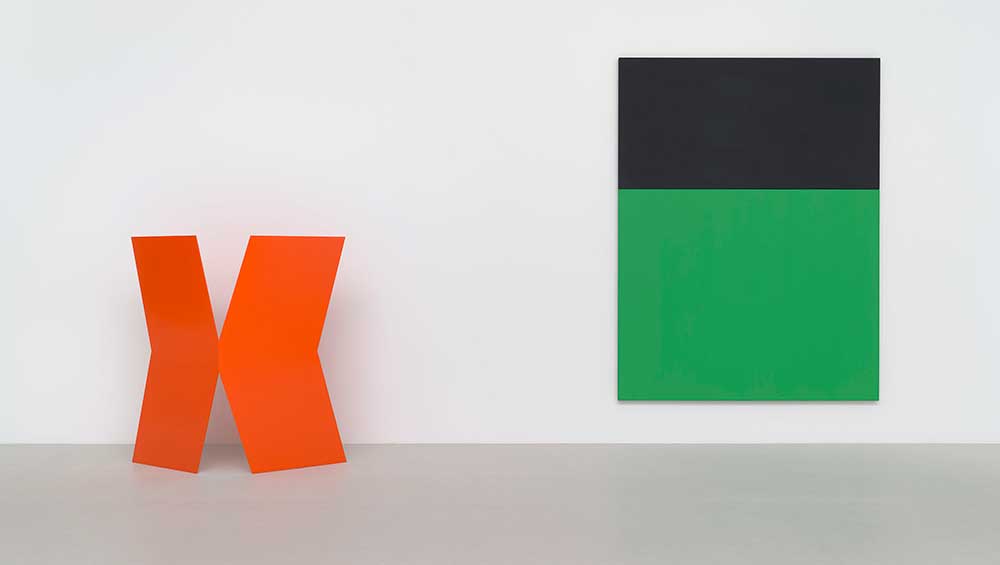
Ellsworth Kelly. From left: Gate, 1959. Painted aluminium, 67 x 63 x 17 in (170 x 160 x 43 cm). Collection Walker Art Center, Minneapolis; Gift of Kate Butler Peterson, 1997; Black Green, 1970. Oil on canvas, two joined panels, 110 x 84 in (279 x 213 cm). Glenstone. All artworks © Ellsworth Kelly Foundation. Photo: Ron Amstutz. Courtesy: Glenstone Museum, Potomac, Maryland.
Glenstone, Maryland
4 May 2023 – March 2024
by LILLY WEI
If you think Ellsworth Kelly (1923-2015) is everywhere these days, you would be right – or close enough. For the centennial of the American master’s birth, exhibitions are planned throughout the US and abroad over the next year, from museums, art institutions and galleries such as the Museum of Modern Art, the Philadelphia Museum of Art, the Art Institute of Chicago, the Blanton Museum in Austin to Lever House in Manhattan and the Edward Hopper House in Nyack, New York, along with events at the artist’s Spencertown compound upstate where he lived and worked for nearly 50 years. Kelly is so closely identified with New York that the city’s mayor, Eric Adams, declared 31 May, the date of what would have been his 100th birthday, Ellsworth Kelly Day (as did other US cities, the honour even more notable in a country not known for honouring its artists).
However, if possible, go to Glenstone, the private museum in Potomac, Maryland, near Washington, DC, to begin. The exhibition, Ellsworth Kelly at 100, overseen by Yuri Stone, the museum’s lead curator on the project, features 70 of the artist’s works spanning the seven prolific decades of his career: paintings; sculptures; works on paper (including his delightful, covetable botanical drawings that display the sensitivity of his touch, its tremolo delicacy also evident in the prodigious number of self-portraits and portraits he drew); and a cache of rarely shown photographs.
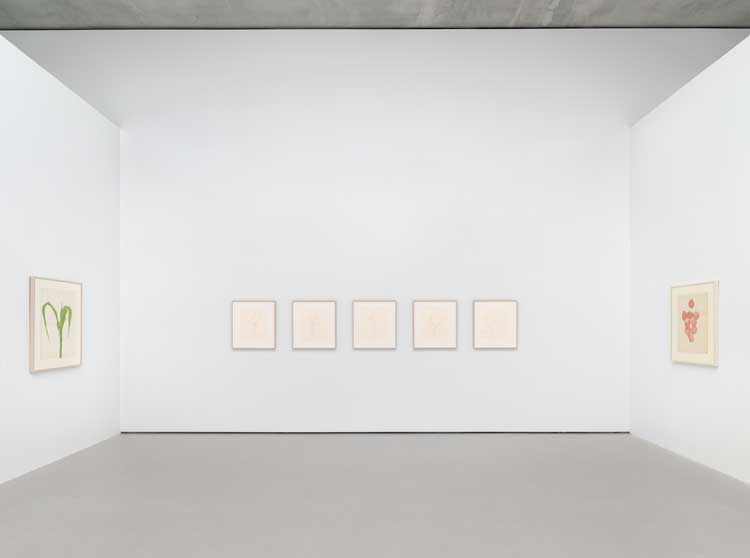
Ellsworth Kelly. From left: Corn, 1959. Watercolour on paper, 28 ½ x 22 ½ in (72 x 57 cm); Cyclamen, 2000. Set of five drawings pencil on paper, 16 ⅛ x 14 in (41 x 36 cm) each; Apples, 1949. Watercolour and graphite on paper, 24 ¾ x 19 ⅜ in (63 x 49 cm). All artworks © Ellsworth Kelly Foundation. Photo: Ron Amstutz. Courtesy: Glenstone Museum, Potomac, Maryland.
A primer of sorts of the artist’s legacy, the exhibition is concise yet comprehensive, each grouping, each work offering another perspective, another variation to see and think about, reminding us that the resolutions of geometric abstraction are no less infinite than those of representational art. The selection is judiciously balanced and unobtrusively, yet provocatively installed, the conversation between the works bracing. The works are meticulously placed, many chronologically by medium and within the space, but not always, and do not feel overdetermined, propelled more by visual fluidity in an exceptionally fortunate collaboration between work and site.
One of the many takeaways is how remarkably fresh Kelly’s art looks, as if just made. Instantly recognisable, the clarity of the boldly coloured, precisely articulated, pared-down forms is doubly reassuring in our era of escalating uncertainty. Another is a reminder that the essential pleasure of art – of which there are many here – is perceptual and material, whether non-objective or activist. And another is his extraordinary, even obsessive, attentiveness to detail and the small differences that generate new work.
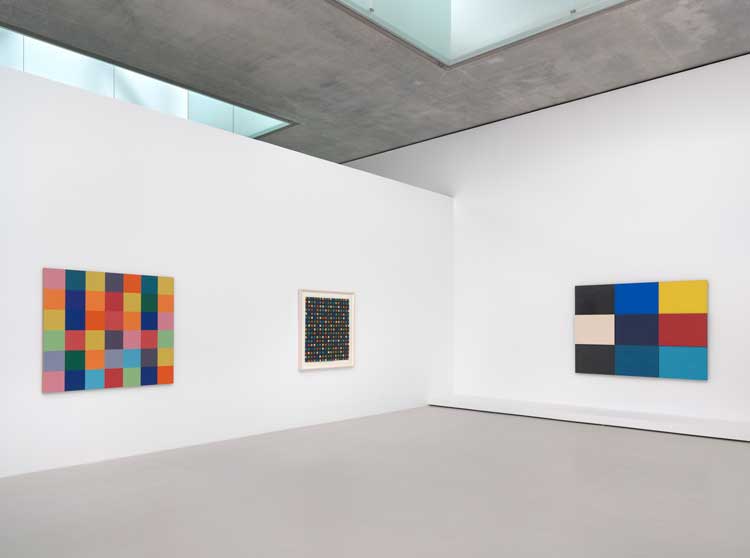
Ellsworth Kelly. From left: Sanary, 1952. Oil on wood, 51 ½ x 60 in (131 x 152 cm). Collection of Marguerite and Robert Hoffman; Spectrum Colors Arranged by Chance IX, 1953. Collage on paper, 38 ¼ x 38 ¼ in (97 x 97 cm). Private Collection; Méditerranée, 1951-1952. Oil on wood, nine joined panels, three in relief, 59 ¼ x 76 ¼ in (150 x 194 cm). Tate: Presented by the Artist and Jack Shear in honour of Sir Nicholas Serota (Tate Americas Foundation) 2021. All artworks © Ellsworth Kelly Foundation. Photo: Ron Amstutz. Courtesy: Glenstone Museum, Potomac, Maryland.
After serving in the US navy in the second world war, Kelly went to Paris on the GI Bill [a law that provided a range of benefits for returning veterans], where he lived from 1948 until 1954. They were formative years for Kelly (he spoke about them often) in which he abandoned figuration and the easel, discovered monochromatic painting, hard-edged shaped canvases, the grid, multiple panels and the flexibility of scale, and embraced chance. Falling under the spell of Piet Mondrian, Marcel Duchamp, Constantin Brâncuși, John Cage and other pioneering modernists, he also imbibed a heady draft of postwar optimism that never seemed to abate.
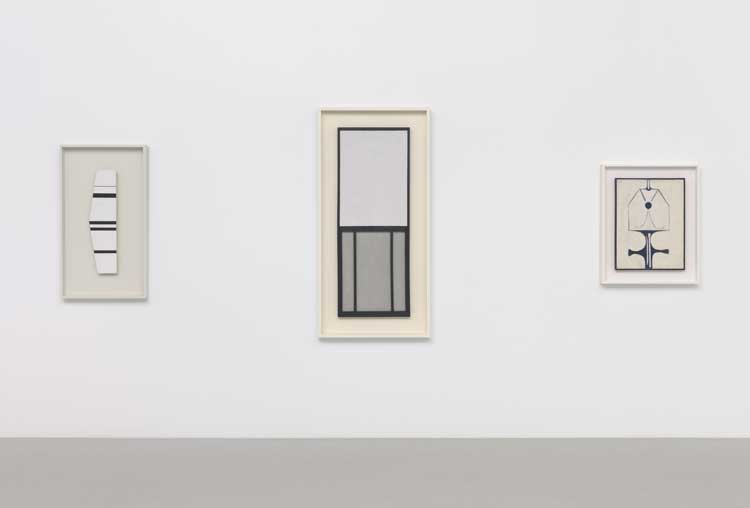
Ellsworth Kelly. Left: Window V, 1950. Oil on wood, 27 ½ x 7 ¼ in (70 x 18 cm). Family Forman Collection; Centre: Window, Museum of Modern Art, Paris, 1949. Oil on wood and canvas, two joined panels, 50 ½ x 19 ½ in (128 x 50 cm). Centre Pompidou, Paris National Museum of Modern Art / Centre of Industrial Creation; Right: Toilette, 1949. Oil on canvas with painted wood frame, 24 ¾ x 18 ¾ in (63 x 48 cm). Private Collection, Courtesy Matthew Marks Gallery All artworks © Ellsworth Kelly Foundation. Photo: Ron Amstutz. Courtesy: Glenstone Museum, Potomac, Maryland.
The first “object” he made, as he called it, joining two canvases together, was Window, Museum of Modern Art, Paris (1949), the show’s opening salvo. Kelly said that the windows in an exhibit there interested him more than the paintings. The realisation that the subject was already there, complete, with no need to compose was revelatory. He could take whatever he wanted from it. It all belonged to him. And his abstractions are firmly grounded in reality and the natural world, as the black-and-white photographs here confirm: a curve of a hill or a bridge, a rectangle created by a skinny steel pipe and its double shadows, the painted line on a street.
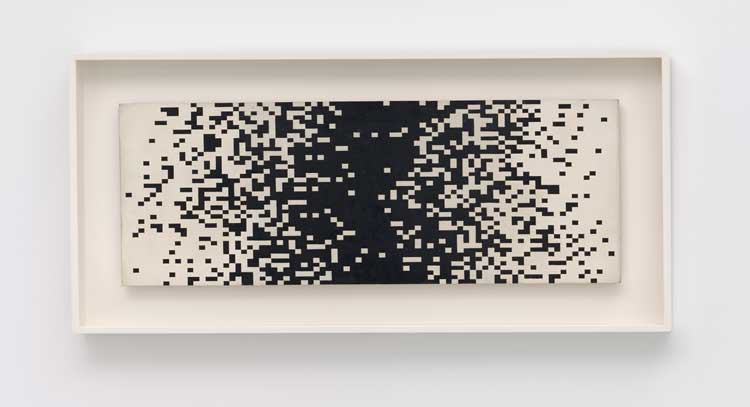
Ellsworth Kelly. Seine, 1951. Oil on wood, 16 ½ x 45 ¼ in (42 x 115 cm). Philadelphia Museum of Art: Purchased with funds contributed in memory of Anne d'Harnoncourt and other Museum Funds, 2008. All artworks © Ellsworth Kelly Foundation. Photo: Ron Amstutz. Courtesy: Glenstone Museum, Potomac, Maryland
Another early work from his Paris years is Seine (1951), a black and white painting that summons up a Mondrian plus and minus work. It seems a cross between impressionism, pointillism and digitalisation and a persuasive equivalent of light splintering across water, as true as any representational mode.
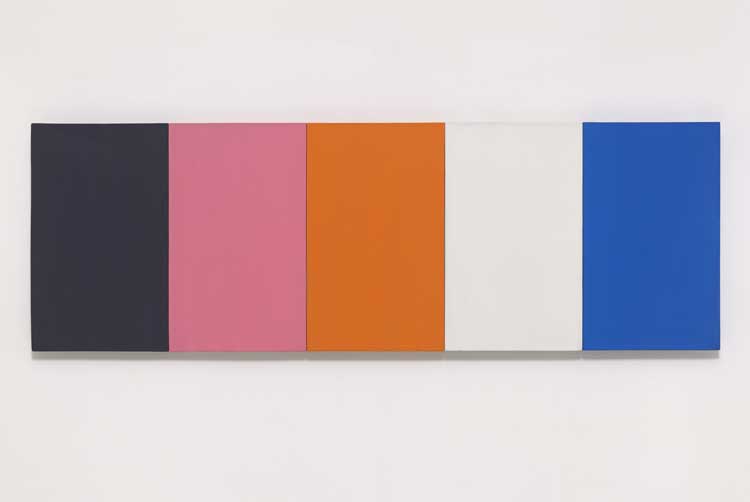
Ellsworth Kelly. Painting for a White Wall, 1952. Oil on canvas, five joined panels, 23 ¾ x 71 ¼ in (60 x 181 cm). © Ellsworth Kelly Foundation. Photo: Ron Amstutz. Courtesy: Glenstone Museum, Potomac, Maryland.
And another is Painting for a White Wall (1952), a polyptych that suavely tweaks the modernist palette by placing adjacent to each other a rose and a red orange that optically jolt, substituting them for a canonical red and yellow, and inserting a white panel that could also be read as the wall, a break in the painting. There is also a free-standing, fire-truck red sculpture configured like the letter X, Gate (1959), that while relatively flat, acquires a surprising degree of dimensionality through the slight fold at the centre of each of its two panels, as if bowing, and then shifts back to a more two-dimensional reading.
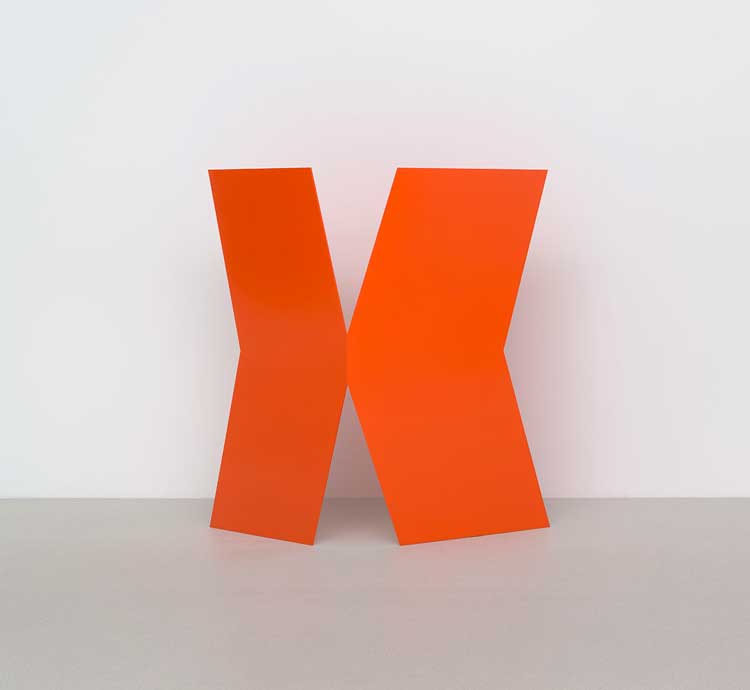
Ellsworth Kelly. Gate, 1959. Painted aluminium, 67 x 63 x 17 in (170 x 160 x 43 cm). Collection Walker Art Center, Minneapolis; Gift of Kate Butler Peterson, 1997. All artworks © Ellsworth Kelly Foundation. Photo: Ron Amstutz. Courtesy: Glenstone Museum, Potomac, Maryland.
The role of the white wall behind it is a familiar one: both ground and not-ground. In a similar manner, the elegant redwood panel soaring 15 feet upwards, flared at the top (and not at the bottom as it might be) interacts with the space and architecture, alternating playfully between flatness and the roundness expected from a column in a kind of optical trompe l’oeil that is part formal, part psychological.
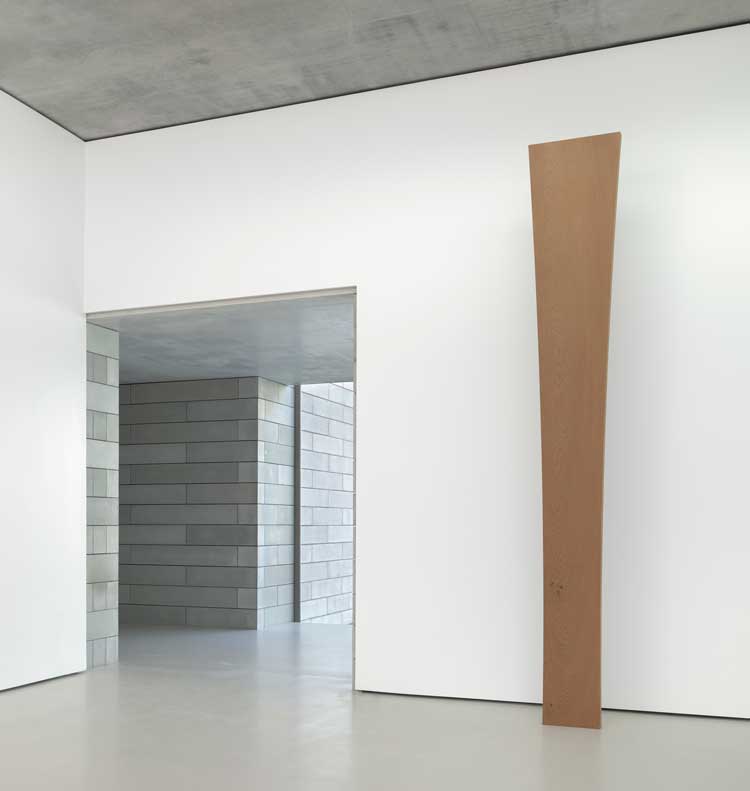
Ellsworth Kelly. Untitled, 1996. Redwood, 176 ½ x 25 ½ x 4 ½ inches (448 x 65 x 11 cm). © Ellsworth Kelly Foundation. Photo: Ron Amstutz. Courtesy: Glenstone Museum, Potomac, Maryland.
One highlight of the show, carefully reconstructed, is laid out on the floor like a wedge of solid sunlight, or lemon icing, or, of course, an object. Called Yellow Curve (1990), it is the first of a series of Kelly’s monumental floor works (this one takes up more than 600 sq ft/56 sq metres) and has not been shown since then. It seems straightforward with the simplicity that characterises all his work, but it is also an inquiry as to what painting is, what sculpture is, its identity as an independent object emphasised by its placement on the floor, to be seen and experienced in that capacity, freed from the wall.
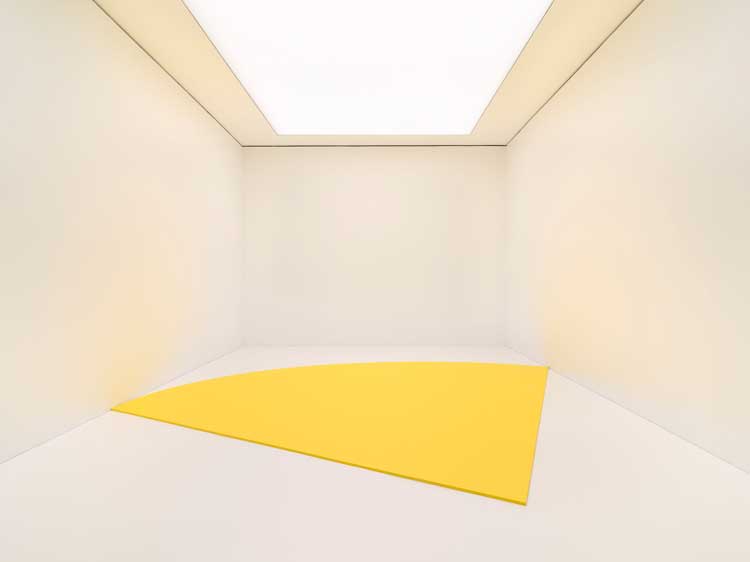
Ellsworth Kelly. Yellow Curve, 1990. Acrylic on canvas on wood, 306 x 292 x 1 in (777 x 742 x 3 cm). © Ellsworth Kelly Foundation. Photo: Ron Amstutz. Courtesy: Glenstone Museum, Potomac, Maryland.
Kelly has been part of the history of contemporary American art for so long that we think we know it – which is what happens to the iconic: revered but no longer really seen. The great gift of this exhibit – ranging from high seriousness to play – is to review the trajectory of his production in one place, showing us that it is much more complex than might be remembered, his signature economy of means not an economy of vision, but pure, clear-headed Americana at its confident best. Happy Birthday, Mr Kelly.
• A modified version of Ellsworth Kelly at 100 will travel to the Fondation Louis Vuitton, Paris, in spring 2024. It will open at the Fire Station, Doha, Qatar, in autumn 2024.